
Mantidae is one of the largest families in the order of praying mantises, based on the type species Mantis religiosa; however, most genera are tropical or subtropical. Historically, this was the only family in the order, and many references still use the term "mantid" to refer to any mantis. Technically, however, "mantid" refers only to members of the family Mantidae, and not the 14 remaining families of mantises. Some of the most recent classifications have promoted a number of the mantid subfamilies to the rank of family, e.g. Iridopterygidae, Sibyllidae, Tarachodidae, Thespidae, and Toxoderidae, while other classifications have reduced the number of subfamilies without elevating to higher rank.
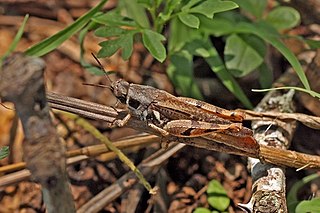
The subfamily Catantopinae is a group of insects classified under family Acrididae. Genera such as Macrotona may sometimes called "spur-throated grasshoppers", but that name is also used for grasshoppers from other subfamilies, including the genus Melanoplus from the Melanoplinae. Indeed, the delimitation of these two subfamilies needs restudy: the Podismini for example are sometimes placed here, sometimes in the Melanoplinae.

The grasshopper subfamily Acridinae, sometimes called silent slant-faced grasshoppers, belong of the large family Acrididae in the Orthoptera: Caelifera.

Sjöstedt's greenbul is a species of songbird in the bulbul family, Pycnonotidae. It is found in western and central Africa.

Sphodromantis is a large genus of praying mantises concentrated in Africa, sometimes considered a synonym of the genus Hierodula: from the same tribe, Paramantini. Outside their range especially, many share the common name African Mantis.

Macrotona is a genus of grasshoppers in the family Acrididae and tribe Catantopini. It includes eight described species and around 35 undescribed species. They are often found in association with spinifex.
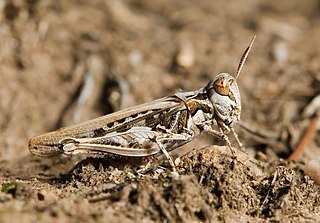
Austroicetes is a genus of grasshoppers in the subfamily Oedipodinae and family Acrididae. Members of the genus typically feed on grass and herbs.
Meruana is a genus of African grasshoppers in the family Acrididae, subfamily Hemiacridinae from eastern Africa.

Neotermes is a genus of termites in the Kalotermitidae family. The genus was first described by Nils Holmgren in 1911, and the type species is Neotermes castaneus. All species are obligate nesters of wood.
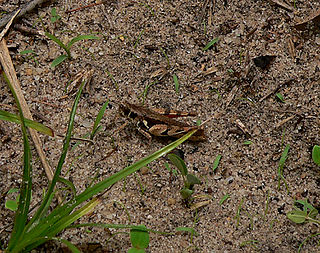
Catantopini is a tribe in the subfamily Catantopinae, a group of grasshoppers found in Africa, Asia and Australia.

Austracris is a genus of Orthoptera: Caeliferan insect in the family Acrididae: subfamily Cyrtacanthacridinae. It includes an Australian pest, the spur-throated locust.

Valanga is a genus of "bird grasshoppers" in the subfamily Cyrtacanthacridinae. Species are found from the Indian subcontinent through southeast Asia and the Korean peninsula to Australia and the Pacific islands.

Trinervitermes is a termite genus belonging to family Termitidae. Members are native to the Old World. They inhabit grasslands and store grass in their nests or mounds, just below the ground surface. Their grass-collecting activities are mainly nocturnal. The soldier caste has atrophied mandibles and a fontanelle squirt gun on the frons. Diterpenes and monoterpenes are released to deter ants and smaller predators, but these are not effective against larger mammalian predators. Due to the snout on the head of soldiers and their grass-collecting habits, they are known as snouted harvester termites.
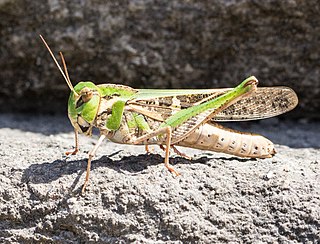
Gastrimargus is a genus of grasshoppers in the subfamily Oedipodinae. The recorded distribution of species in this genus includes Africa, Asia, and Oceania.

The Hierodulinae are a subfamily of praying mantids, originally used by Brunner von Wattenwyl. It was restored as part of a major revision of mantid taxonomy, and now contains genera previously placed elsewhere in the family Mantidae.
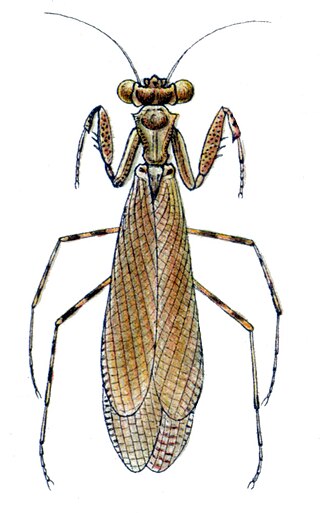
Phthersigena is an Australasian genus of praying mantids: in the subfamily Fulciniinae and tribe Paraoxypilini. It is one of several genera containing certain species called "unicorn mantids", due to a process on their heads.

Acorypha is a genus of grasshoppers belonging to the family Acrididae.
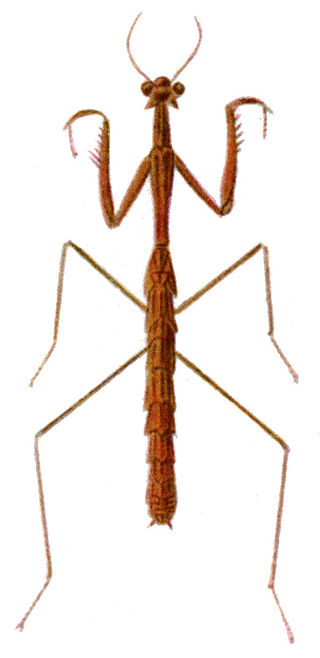
Hoplocorypha is a genus of mantises belonging to the family Thespidae.
Prorhinotermes is a genus of termites belonging to the family Rhinotermitidae.
















